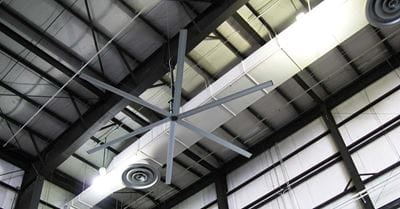HVLS Fans | San Diego, CA

For plants or warehouses, HVLS fans can have a significant influence on both heating and cooling costs and worker morale.
What Is An HVLS Fan?
An HVLS, or “high volume, low speed” fan is a massive ceiling mounted fan that rotates at comparatively slow speeds and distributes climate controlled air throughout a space. They are generally put to use in areas with higher ceilings, such as manufacturing plants, warehouses, and other industrial facilities.
In warm climates or during the summer, this type of fan can assist with the removal of unwanted moisture from the air by substituting high temperature, moist air with drier air. During cooler months, they can also help manage temperature by thoroughly circulating warm air through a building.
HVLS Fan Size
HVLS fans are at least 84 inches across. Some varieties can be as large as 24 feet across, although for almost all commercial configurations numerous smaller fans are used. Fan output varies, but nearly all HVLS units are between ⅝ horsepower and 1 horsepower.
Though the vast majority of HVLS fans are meant to be mounted on ceilings, some can be configured to attach to floor mounted poles.
How Do HVLS Fans Work?
An HVLS fan’s effectiveness is due to its slow RPM and mammoth size. HVLS fans generate huge segments of air that proceed at low speed, in contrast to the rapidly moving, modest air currents that are created by conventional ceiling fans. Tumultuous, accelerated air output from average fans produces friction against stationary air and speed quickly dwindles.
When you use an HVLS fan, the bigger air currents move more gradually and go greater distances because there is far less air friction. For this reason, it takes much less electricity to push greater volumes of air slowly than it takes to move smaller volumes of air at a quicker speed.
The differential in power consumption is surprising. It takes nearly 27 times more energy to move air at 6 miles per hour versus moving air at 2 miles per hour. The bottom line is this: you're much better off running larger fans a very low speeds versus smaller fans at high speeds.
Warehouse HVLS Fan Benefits
Reduce Heating Costs
During the winter months, a single HVLS fan can contribute significantly to energy cost savings.
Air naturally stratifies in large buildings, particularly those with high ceilings. Hot air moves toward the ceiling and the cooler air stays near the floor. Heating systems must work furiously to warm the space close to the floor, which costs money, while almost all of that warmed air moves toward the ceiling, away from workers.
HVLS fans can move large quantities of warm air down from the ceiling, recirculating it throughout the space, thereby stabilizing the temperature and enabling the HVAC system to work more efficiently.
Reduce Cooling Costs
While HVLS fans are perfect for maintaining heat in a building, the reverse is also true: they can help with cooling during the summer months or in regions that are consistently warmer.
HVLS fans keep air circulating throughout sizable areas, and this movement generates an evaporative cooling effect. Although the fan does not truly transform the temperature of the air flowing down, it will naturally evaporate moisture in the air, establishing a more comfortable environment.
Reduce Environmental Impact
While saving money on energy costs is a fantastic reason to consider HVLS fans, there is the extra benefit that reducing electricity usage also improves a business’ carbon footprint. Over time, HVLS fans can provide meaningful reductions in energy use, especially for operations with many sites.
Improve Employee Morale & Productivity
Content workers are usually more effective, so keeping your facilities at optimal temperatures is profitable. Several studies have proven a correlation between inhospitable temperatures and declines in productivity.
HVLS Fans For Sale Near Me
If you’re interested in learning more about the advantages of HVLS fans for your warehouse or production facility, call a professional at Raymond West today.
Raymond West's San Diego facility serves all of San Diego County, including Carlsbad, Chula Vista, Downtown, El Cajon, Escondido, Fenton Carroll Canyon, Grantville, Kearney Mesa, Levanto, Morena, National City, Oceanside, Otay, Otay Mesa, Poway, San Marcos, Santee, Sorrento Mesa, Spring Valley, Vista and all surrounding areas.
Raymond West | San Diego Material Handling Equipment Supplier
8221 Arjons Dr # B2
San Diego, CA 92126
(858) 679-1800

